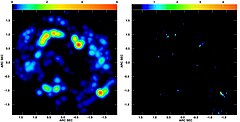European VLBI Network

The first e-VLBI science image produced by the European VLBI Network
|
|
| Alternative names | EVN |
|---|---|
| Website | www |
| Telescopes | Cambridge MERLIN telescope Medicina 32-m radio telescope Metsahovi 14m radio telescope Nanshan Radio Telescope Noto 32-m radio telescope Onsala Space Observatory 20 m telescope Onsala Space Observatory 25 m telescope Sheshan 25m radio telescope Toruń RT4 Wettzell 20m radio telescope Arecibo Observatory Effelsberg 100-m Radio Telescope Hartebeesthoek Radio Astronomy Observatory Lovell Telescope Madrid Deep Space Communication Complex Mark II Westerbork Synthesis Radio Telescope Yebes Observatory RT40m |
|
[]
|
|
The European very-long-baseline interferometry (VLBI) Network was formed in 1980 by a consortium of five of the major radio astronomy institutes in Europe (the European Consortium for VLBI). Since 1980, the EVN and the Consortium has grown to include 9 institutes with 12 radio telescopes in 8 western European countries as well as associated institutes with telescopes in Italy, Poland, Russia, Ukraine, China and South Africa. Proposals for additional telescope in Spain are under consideration, and furthermore, the EVN can be linked to the 7-element Jodrell Bank MERLIN interferometer in the UK and to the US Very Long Baseline Array (VLBA) to create a "global network". In 1993 the Joint Institute for VLBI in Europe (JIVE) was created, with the Netherlands Foundation for Research in Astronomy (Dwingeloo) acting as the host institute. It will provide both scientific user support and a correlator facility. Very Long Baseline Interferometry (VLBI) achieves ultra-high angular resolution and is a multi-disciplinary technique e.g. imaging of extragalactic radio sources, geodesy and astrometry.
The EVN network consists of 21 telescopes:
Additionally the EVN often links with the UK-based 7-element Jodrell Bank MERLIN interferometer. It can also be connected to the US Very Long Baseline Array (VLBA), achieving a global VLBI, obtaining sub-milliarcsecond resolution at frequencies higher than 5 GHz.
Since 2004, the EVN has started to be linked together using international fibre optic networks, through a technique known as e-VLBI. The EXPReS project was designed to connect telescopes at Gigabit per second links via their National Research Networks and the Pan-European research network GÉANT2, and make the first astronomical experiments using this new technique. This allows researchers to take advantage of the e-EVN's Targets of Opportunity for conducting follow-on observations of transient events such as X-ray binary flares, supernova explosions and gamma-ray bursts.
...
Wikipedia
